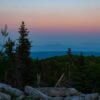I had always closed my eyes while on highways. My mother and I would frequently take road trips after my days at pre-school and her long days at work to drive up north to my Aunt’s house. She seemed to take advantage of these trips, and began to clear her head once her mind was on the road rather than everything else. I slowly became more patient during these forty-five-minute drives by watching a movie and eventually falling asleep in my car seat. The trip mainly consisted of one long highway, with nothing but orange and browning trees and bushes on either side of the road.
My mother instructed me to always look straight ahead while in the car, or just close my eyes shut altogether. I was told this was because my family all deals with terrible motion sickness, but as I grew I realized it was because she couldn’t promise the busy Pittsburgh parkways wouldn’t be littered with animal carcasses on either side of the road. I counted eight dead deer scattered during one trip during the early fall.
———
There are over 235,000 reported cases of animal-vehicle accidents annually. With that, an estimated 1.2 million deer are murdered and 365 million various other animals are found lying on the side of the road. This is all the total of the decay left from skin and rotting tissue stranded after an eighteen-wheeler hits a groundhog, when a bird flies into the wings of a plane, or when a train hits cattle. In addition, 1.2 million domesticated dogs, 5.4 million cats and 5,000 humans, animals which were once safe in houses crushed by vehicles parked in their driveways not far away.
This number began to drop drastically in 2020, following the pandemic. Humans were forced inside, fighting illness, and nature began to heal for the first time.
———
I noticed, when I was young, more deer appeared crumbled on the side of the road during fall. The window of our car was cold to the touch and the freezing streets operating as nature’s refrigerator were just getting started. Misshapen corpses of various deer bodies, some large with antlers, some as small as a dog, awkwardly bent with their legs pointing unnatural directions began appearing not even ten feet from our car.
Once I was finally tall enough to peek over my car seat and out the window, I began crying at my first sight of a dead deer.
The deer looked small. I know my mother saw it as well; she looked off to her left and then shut her eyes lightly. Leaves were falling, the sun was setting later, and more and more deer got caught stumbling across the road. Wrong place, wrong time.
———
I watched Bambi for the first time like a deer in headlights. Sitting under a blanket comfortably with my mom, holding me against the harsh winter outside, I watched the young deer run away on fields of spring snow with echoes of gunshots firing off screen. He kept running, never looking back for his mother who was following close behind. Bambi found shelter under some bushes, collapsing asleep after his innocence and mother were taken away. With tears streaming down my face, burning my cheeks, I held my own mom tighter.
———
Road ecology—the study of the ecological effects (both positive and negative) of road and highways.
In the US, only around 20% of deer-vehicle accidents occur during the day. These rates increase around dusk, resulting in accidents eight times more frequent once night falls. Deer have been found to move greater distances during the night, specifically when the moon is out.
Bucks often spend the autumn seasons mating and competing others. Daylight savings has also shown a pattern in rising cases, shifting the clock back an hour and thus moving early morning workers’ traffic to an earlier time, something deer aren’t accustomed to. Insurance companies report in one year alone they had 1.9 million claims for collisions with wildlife, 90% of that involving deer.
———
I found myself from an early age wondering what privilege I deserve to be able to crush helpless rodents under the tires of a vehicle just so I can get to my destination. The common morals are that the wild animals are innocent and humans are monsters for killing them mindlessly. Media with animals leave viewers with a sometimes harmful view of nature as tame and wild animals adorable, creating a distaste for important procedures to contain forests. A place where violence, killing, starvation and natural competition begin to be met with compassion.
Roadkill begins to crush these morals in an unfamiliar way, creating accountability from humans just driving in a brutal world. Those driving upstate didn’t design the roads, they have no say in where they are located or the uprooting of wildlife, they are just forced to take advantage of it because there isn’t a better option. Some humans simply don’t care, some take advantage of the meat off the road by claiming it was killing more ethically than processed or farm meats, and some are left with the burden of knowing their desire to accelerate from place to place had left a massive toll on the animal world.
Is this an individual’s fault, or it really the price which must be paid for modernity? Every person who accidentally swerves into a deer isn’t a murderer, but the leftovers of the accident remain on the road until they are picked up, or slowly disappear. Should there be any guilt toward the deer with misshapen legs left in plain sight, or the figure whichwas once a skunk being mushed into almost nothingness?
This creates a complex relationship with the familiarity people develop with death. How is it watching a deer lose his only caring family member by bullets from a hunter’s gun is so jarring in a cartoon but not when it is displayed outside our cartoons? Why have we normalized the smell of a dead skunk or walking past a racoon sitting in a clearing off the road because it was hit and stumbled away toward its eventual death? Why is it never a topic of conversation toward the effect our speed has on animals, but the inconvenience it is to see a large deer lying in plain sight?
———
I began learning to drive around eight months ago. My mom was insistent on teaching me to drive herself, despite my plea to just get a driving instructor to avoid the fighting that the tension of being in a car could create. She took me to an empty elementary school parking lot to drive in the evening while the sun was setting and fallen brown leaves were beginning to gather in gutters. I watched as she gripped her seatbelt, and the mix of both shock and fear in her eyes as I stopped the car to remember which way was left. Despite shifting in the driver’s seat multiple times, I couldn’t get comfortable driving the minivan I had grown up in, trying to move the steering wheel despite clammy hands and struggles to remember what to do.
I drove for the first time on a side-street. The leaves were falling and I insisted on turning the seat warmers on. It was harder than to separate memories of weekday nights, flinching at the sight of animals crushed to a pulp to my own feet on the brake, my own eyes on the road.


